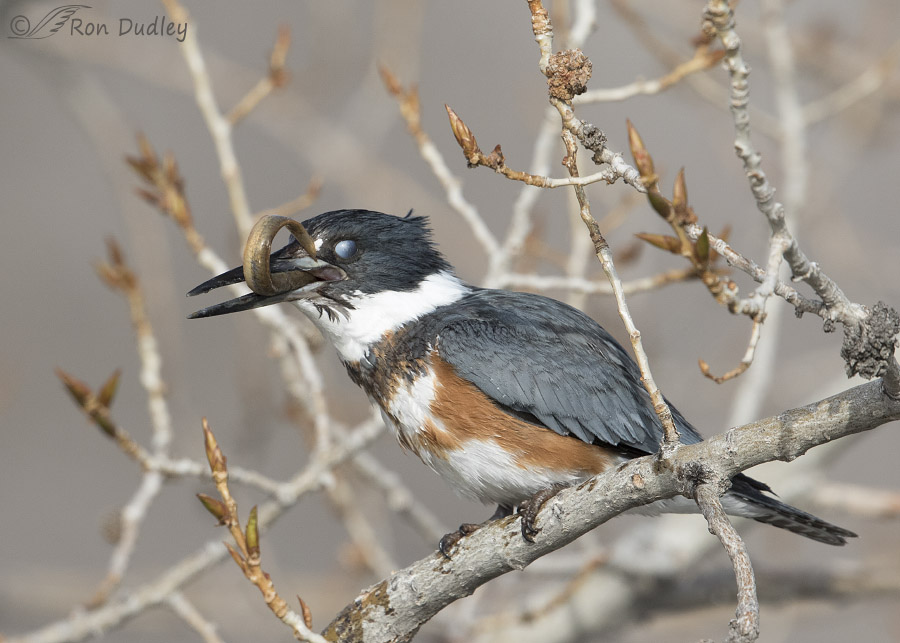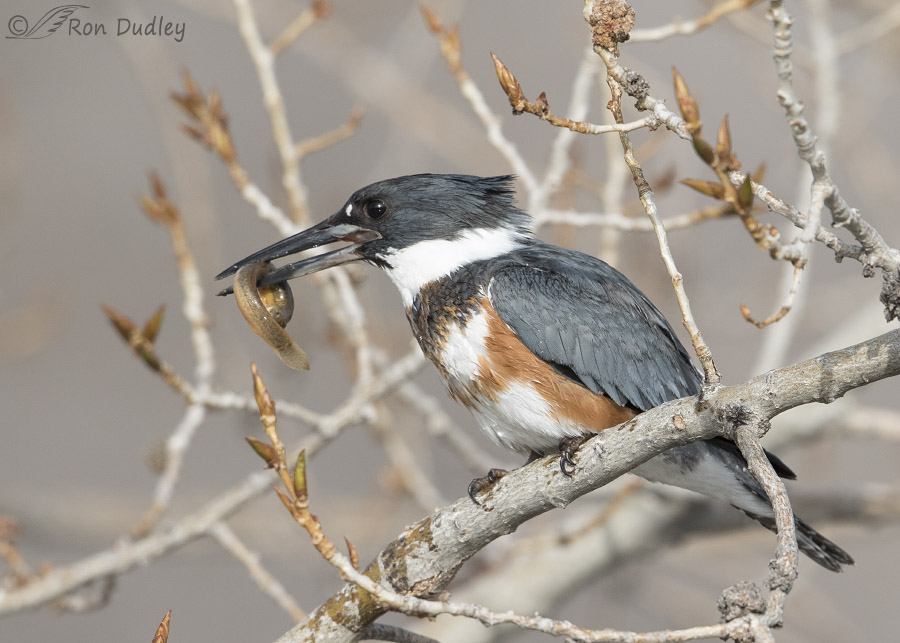And this time she has a fish.
Many readers will remember this female Belted Kingfisher I photographed multiple times in various settings back in February of 2016 at a local pond near my home because I’ve posted several images of her in this setting before. But these photos are new to my blog.
1/1600, f/7.1, ISO 800, Canon 7D Mark II, Canon EF 500mm f/4L IS II USM + EF 1.4 III Extender, not baited, set up or called in
She caught an invasive weather loach in the pond and then she considerately brought it to a perch close to me to work it over before swallowing it (the wet spots on the perch below her bill are where she’d slammed the fish against the branch to stun it). The setting is busy but I have good detail on both bird and loach and in this shot I caught the fish in a clear spot between blurry twigs in the background.

1/1600, f/7.1, ISO 800, Canon 7D Mark II, Canon EF 500mm f/4L IS II USM + EF 1.4 III Extender, not baited, set up or called in
The loach is so long-bodied she had a difficult time getting it down. The tail was still flailing and there was danger of it striking her eye so she closed her nictitating membrane for protection during the process.
I’ve been thinking about something lately. In the past I’ve always been quite reluctant to post bird photos where the membrane is visible because it looks so bizarre to some folks, especially when it’s as opaque as those in kingfishers. I shouldn’t have been. After all, two of the primary focuses of my blog are bird biology and behaviors and the membrane involves both. So I’ve decided that in the future I won’t be so hesitant to post images where the membrane can be seen.
Sometimes I’m a slow learner but after many years of bird photography and blogging I finally realized that what I was (not) doing was illogical considering my style and continuing interests.
Ron



Ron, this post was very informative and a ‘teaching’ moment for me!!
I’ve never seen a bird with a fish in its mouth nor have I seen a fish being swallowed by a bird [never mind swallowed ‘whole’].
The membrane in the eye is pretty amazing and useful to this Kingfisher.
BTW, sorry to taunt, but our hummers are still here drinking away. I thought is might be too cold for them at 5,300 elevation on the benches.
Thank you, Ron.
Thank you, Alice. And yes, I’m still jealous about your hummers!
Maybe they’ve been watching the weather forecast with temps rising in the next few days!! Maybe they are a very smart bird. Thanks for your reply.
Add me to the looooooong list of people who come here (among other things) for the education.
Love this beautiful bird and I would have my eyes tightly shut if there was the slightest danger of being ‘slapped in the face with a wet fish’.
Glad to hear that some at least of your self censorship has stopped.
“I would have my eyes tightly shut if there was the slightest danger of being ‘slapped in the face with a wet fish’”
You do have a way with words, EC! Thank you.
So jealous!! Gorgeous .. I do not mind membranes
🙂
The nictitating membrane does look quite weird, but it does show an important behavior. I’m happy to see this beautiful lady again. She’s been one of my favorite birds that you’ve posted.
Thanks very much, Susan.
Mr. Spock is pleased that you are no longer being illogical. (Sorry, it had to be said. 😉 )
These are wonderful shots. I’ll echo the others in saying that the reason I come here is to feel the amazement at all the cool things that birds can do and for the joy of adding a precious nugget of learning to my day.
Now, put down that delete key and step away from the computer. 😉
I’m always happy to please Mr. Spock, Marty. He and I share an appreciation for logic AND having spectacular ears…
You’ll be pleased to know that I can no longer find my delete key – all of the letters have worn off of it. 🙂
I actually did “laugh out loud” at your delete key comment. 🙂
Ron, thanks for “changing” on nictitating membranes. Yes pretty photos are all over. Teaching birdy blogs are few and far between. I like many others see your blog first thing. Your “pretty” photos help teach us.
Have you read Michael Furtman’s blog on owl baiting? I do not know if you allow us to include links to other sites here. I can send the link in a response with it later if that is OK.
Oh being techy with camera stuff is fine with a few of us.
later jake
Thank you, Jake.
Yes, I’ve seen Furtman’s post and thought it was very well done. I was particularly interested in the screen shots of his communications with David Hemmings (“professional owl baiter”). IMO it says a lot about Hemmings and probably many other owl baiters too.
Here’s the link: http://www.michaelfurtman.com/On_Owl_Baiting.htm
Man, I knew I shouldn’t have followed that link. I’d like to “bait” some of *them,* if you catch my drift. Selfish a-holes!
It’s an eye opener, isn’t it, Marty. Raptor baiting, of owls and otherwise, is much more common than most people think. That’s why I always include “not baited” with all my bird photos. Those jerks are folks I REALLY don’t want to be associated with!
Watched the link re: Baiting…sickening! Thanks for providing it, though…
Interesting photos, especially the second which shows the membrane so clearly…judging from the apparent action of the loach, it’s a good thing they do have this thicker protection. One of the main things I appreciate about your photos is that they aren’t just “pretty bird pictures”, but that they show what so many others don’t…the behaviors and real life situations you are “lucky” enough to witness and capture. I must admit to feeling sorry for the poor loach, struggling with all its tiny might to survive…yet, I’m glad the Queenfisher found food….still,.Mother Nature is a bitch!
“One of the main things I appreciate about your photos is that they aren’t just “pretty bird pictures””
I appreciate that, Patty! When I started blogging I knew Feathered Photography would be just a little bit different because of my biology background and my interest in behaviors. I thought that might limit interest in my blog because most folks out there apparently are most interested in those “pretty picture” but over time lots of folks with interests similar to mine eventually stumbled across my blog and many of them have stuck with me. I’ve always been grateful for that.
Thank YOU!!! I think most of us are VERY grateful for the fact that there is at least one (two, counting Mia) that do provide simething else…something meatier. There is plenty of the pretty stuff out there to admire, but you two give us something to learn from…I still find joy in learning. I remember what I see on your bligs…the just pretty stuff, not so much….the difference is very, very important to me…
The effing evil iPad is trying to sabotage me as usual…simething, bligs…someday I just won’t recharge the darned thing…
I always have believed that the nictitating membrane protects the eyes and that any bird coming in contact with a branch, blade of grass, a struggling prey item in its beak etc., will automatically throw that membrane over its eyes for protection. This is a great shot, not only showing the membrane, but also showing the reason behind the reflex with the wiggling loach lashing its tail near the eye. I love your behavior shots, especially when they prove why that nictitating membrane is there in the first place.
Thanks, Dick – you make a good point about that shot being a good representation of the trigger that can cause the membrane to close.
Marvelous shots Ron!
Charlotte
Thanks, Charlotte.
I really like these kingfisher shots Ron. I have noticed in some photos I took of a mother Great Horned Owl and her two fledged young that they seem to deploy the nictitating membrane quite often in their grooming moves, often in postures that I would think were eye-safe. It seems to appear that they lower the membrane as their head gets within a certain close range to a body. Yet there are shots where where they are beak to beak with eyes open which would seem to indicate voluntary control. Thanks for all your great inspiration.
I agree, Dave – it’s likely that control over the membrane can be either voluntary or a reflex, depending on the situation.
Great photo’s – they are hard to capture! 🙂 Showing the nictitating membranes is just part of “who the birds are” and educational in my opinion – glad you’ve evolved on that particular issue. 🙂 On that note, the kingfisher that slammed into our window and that I rescued apparently did have a bit of damage. It’s voice was different when making it’s evening run through the yard – a bit softer and not quite as harsh as it was. Seems to be gone at this point. Also, Belt Creek started running here yesterday – not a lot, but running so storms of a week ago not only helped with the fires, but also the water supply even if it didn’t “run” much.
Interesting that you’d notice that change in voice, Judy – that suggests to me you’re a skilled observer… 🙂
Good news about Belt Creek and your moisture. It’s been a very long time coming!
Neat Kingfisher photos Ron. The silvery blue color of the nictitating membrane is interesting. Do you know if the membrane is used voluntarily, or is it an involuntary reflex? Thanks !
Very good question, Ed. I suspect it’s usually involuntary because many studies have been done on the membrane and reflex actions. However I also suspect it can be closed voluntarily in certain situations (just like our blinking can be both voluntary and involuntary). For example, diving kingfishers always close their membrane just before they impact the water and it would be my guess that it might be voluntary in that situation.
On a related note, I’ve always wondered if the reason kingfisher membranes are so opaque is because they’re extra thick to offer additional protection to the eye when they hit the water. I’ve never been able to find any evidence to back that up though…
It might be interesting to compare the membrane opaqueness of Brown Pelicans and American White Pelicans since one dives for fish and the other doesn’t.
Beautiful picture. belted kingfisher’s are so hard to capture.
They sure are, Barbara. This one was unusually cooperative.